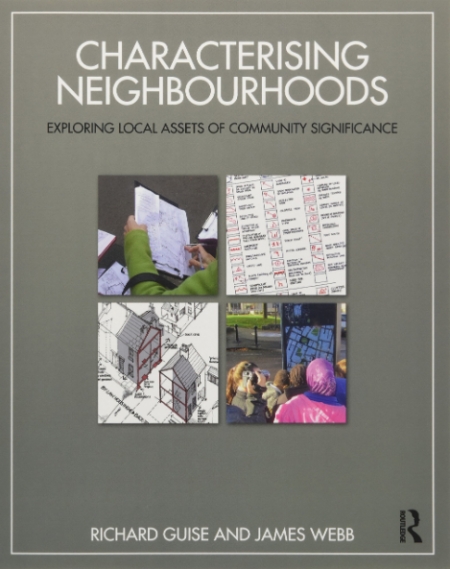Characterising Neighbourhoods: exploring local assets of community significance

|
| Characterising Neighbourhoods: exploring local assets of community significance, Richard Guise and James Webb, Routledge, 2018, 304 pages, fully illustrated, paperback. |
This book deserves to be widely read. Its authors no doubt hoped to come up with a title that would attract the planners, councillors, neighbourhood planning activists, building conservationists, urbanists and students who would benefit from it. Unfortunately, Characterising Neighbourhoods: exploring local assets of community significance is not that title. ‘Characterising’ is a rather clunky term, and it is not clear how ‘exploring local assets of community significance’ relates to it.
What the book does very well is to explain how to assess the character of a place, and how to use that understanding in the planning process. Its strongest feature is the beautiful, annotated drawings by Richard Guise. These communicate brilliantly, and make one regret the thousands of words that other authors write about urban design and conservation without illuminating anything much.
Understanding local character is at the heart of planning, urban design and conservation. If local authorities tell planning applicants one thing about how to develop, it is usually to be responsive to the character of the area. Too often the developer chooses one matter that is in some way locally distinctive – some flint or banded brickwork, perhaps – and uses that to tick the ‘character’ box.
The result is often something that looks ridiculous, all other aspects of the local character having been ignored. In such cases a tokenistic nod to character has been used as an excuse not to think about the complexity of the local context, and to put as little thought as possible into the development’s design.
Because ‘character’ is a simple word, too many people in the built environment professions assume that it must also represent a simple thing. On the contrary, character is shorthand for every aspect of a place considered in its context.
Guise and Webb get to grips with that complexity magnificently. They explain the concept of character and how to use it in neighbourhood planning, urban design and planning decision-making. And they end the book by considering how character can be used in the process of designing development.
A consistent theme is the authors’ belief that many people lack the language to discuss matters of design and spatial planning. They hope that the book’s text, annotated diagrams and captioned illustrations will help to remedy this, and their faith in the book’s effectiveness is surely justified.
They also claim that the map-based notation method that they present ‘provides a common language of characterisation that is available to all’. For those of us who have never used such a notation method, and who wonder if those developed by pioneers such as Gordon Cullen were not just too complicated, we will have to take their word for it. But, whether or not such a notation method is widely usable, the way they discuss their approach to it is, like the rest of this valuable book, highly enlightening.
This article originally appeared as ‘Locally distinctive’ in IHBC's Context 157 (Page 62), published in November 2018. It was written by Rob Cowan, editor of Context.
--Institute of Historic Building Conservation
[edit] Related articles on Designing Buildings Wiki
IHBC NewsBlog
Purcell’s guidance on RAAC for Listed Buildings in England & Wales
The guidance specifically focuses on Reinforced Autoclaved Aerated Concrete (RAAC) in listed buildings.
IHBC Membership Journal Context - Latest Issue on 'Hadrian's Wall' Published
The issue includes takes on the wall 'end-to-end' including 'the man who saved it'.
Heritage Building Retrofit Toolkit developed by City of London and Purcell
The toolkit is designed to provide clear and actionable guidance for owners, occupiers and caretakers of historic and listed buildings.
70 countries sign Declaration de Chaillot at Buildings & Climate Global Forum
The declaration is a foundational document enabling progress towards a ‘rapid, fair, and effective transition of the buildings sector’
Bookings open for IHBC Annual School 12-15 June 2024
Theme: Place and Building Care - Finance, Policy and People in Conservation Practice
Rare Sliding Canal Bridge in the UK gets a Major Update
A moveable rail bridge over the Stainforth and Keadby Canal in the Midlands in England has been completely overhauled.
'Restoration and Renewal: Developing the strategic case' Published
The House of Commons Library has published the research briefing, outlining the different options for the Palace of Westminster.
Brum’s Broad Street skyscraper plans approved with unusual rule for residents
A report by a council officer says that the development would provide for a mix of accommodation in a ‘high quality, secure environment...
English Housing Survey 2022 to 2023
Initial findings from the English Housing Survey 2022 to 2023 have been published.
Audit Wales research report: Sustainable development?
A new report from Audit Wales examines how Welsh Councils are supporting repurposing and regeneration of vacant properties and brownfield sites.
















